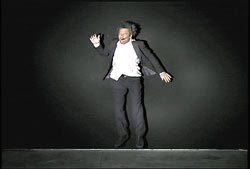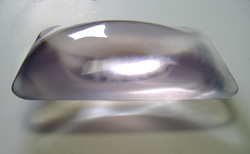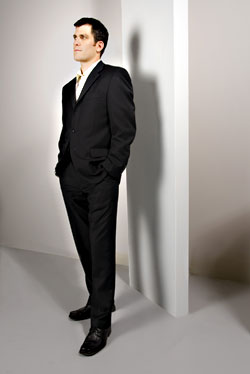Gary Hill’s arguably one of the biggest art stars in Seattle (up there next to Chihuly). And yet his opening last week at 911 Media Arts Center didn’t receive much attention. I can’t blame anyone for ignoring Chihuly’s openings and closings (if you’ve seen one it often feels like you’ve seen them all), but when it comes to Hill’s work, I just don’t get it.
Hill, who helped establish the video program at Cornish in the 1980s, is one of the most important contemporary artists investigating word and language in electronic images. My first encounter with his work was in 2005 when Wall Piece showed at Western Bridge. In a blacked-out room in the back of the warehouse, flashes of a strobe light kept time with a life-size projection of Hill earnestly throwing himself against the wall. The sound of his body whapping against the wall blared over the speakers as he blurted tragic lines from an essay about aging: “I’m going, watching myself go….”
Soon after Wall Piece was up, Hill’s 2001 video Accordions made its Seattle debut at the now-defunct Consolidated Works. On five enormous video screens, portraits of Algerian men and women took over the massive warehouse space. At one moment the camera zoomed in on a single person. In another the faces on-screen flashed on and off like strobes themselves. Because none of these cuts were neatly synchronized, the experience was left poignantly unresolved.
This unsettling quality is a thread throughout Hill’s work, which currently can be seen at both SAM and the Henry. But you don’t have to ping-pong around town in order to experience his affective work. The mini-retrospective at 911 quietly but skillfully contextualizes and traces Hill’s development as a pioneer in video art.
Nestled between the Center’s computer labs is the oldest piece in the show, Hill’s enigmatic Glass Onion from 1981. Through a maze of concentric rectangles installed in the room, the work begs us to consider the way we communicate and survey. It’s part reference to glass houses, part reference to new media’s transparencies, and incredibly prescient. Still, the monitor-filled room didn’t do much for me—the text on the monitors seems basic, and the audio overly repetitive, even while a camera records the activity of the room from above and supposedly captures the viewer’s image within the piece.
A little further down the hall, Hill’s Clover, from 1994, feels more relevant. Hill set up four monitors at eye level on a clean steel platform in the shape of a clover. On the screens, four men are shown from the back walking into what looks like the same forest. Conceptually it appears that they will eventually meet. But they don’t. Hill denies us the ending. Instead, we watch as they methodically put one foot in front of the other, over and over and over again. After the enigmatic layers of Glass Onion, this relatively simple and meditative loop feels good. In fact, at the opening, an artist told me he was about to make a similar piece, an admission that proves just how valuable 911’s show is for local video artists. Hill is the father of this medium: You better know his territory before you go trying to chart your own.
The experience at 911 gets even better as you make your way down the corridor toward the monotonous tones of the male voice that wafts from the Screening Room. Once inside, Hill’s 1995/2002 video Twofold (goats and sheep) envelops the senses. From the video projectors, two sets of male hands are signing the text that’s heard with a delayed echo overhead. Linguistically acrobatic phrases like “the right hand can’t know what the left hand is doing…beforehand” punctuate the expressive movements of the hands signing on-screen. As the relationship between the image and the language gets muddled—at times the echo you hear makes the two images look like they are also out of sync with one another—the rhythm of the piece becomes more seductive.
The same holds true for the show as a whole, which exemplifies exactly the way Hill has carved out the genre. With work that perpetually uses the self-referential aspect of video to push the limits of our experience, Hill has undeniably influenced contemporary video artists like Tivon Rice and Jill Magid. So, if you’re not sure who Hill is, or why he matters, make 911 your first stop and then head to SAM and the Henry. The work deserves your attention.








